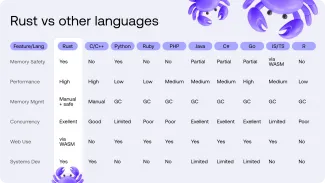Time to Migrate: Why Rust Might Be the Best Decision You Make in 2025
Rust is no longer just a language for enthusiasts and open-source contributors—it's rapidly becoming a go-to choice for companies aiming to build secure, scalable, and high-performing applications.
As modern software applications demand increasing performance and dependability, traditional coding stacks show their weaknesses. CTOs and developers are turning to Rust, a language prized for its uncompromisingly safe memory management and deterministic performance.
In 2025, a Rust transition might no longer be optional. If bugs, tech debt, or scalability are your issues, Rust might be your solution. Find out how Rust Development Services can reframe your architecture and make your product sustainable in the long term.
Why Is Rust Becoming so Popular?
Created by Mozilla, Rust was designed from the ground up to be modern and safe for systems programming without the low-level, raw performance of C/C++.
Key moments in Rust’s journey:
- 2010 – Rust project initiated at Mozilla
- 2015 – Reached stable 1.0 release
- 2021 – Rust Foundation established
- 2024 – Major cloud providers and blockchain platforms adopt Rust at scale
What Types of Projects Are Developed With Rust?
Rust can do more than one thing. It runs everything from operating systems and dev tools to blockchains and microservices. Some of the major categories include:
1. System-Level Software
- Redox OS – A secure OS built entirely in Rust
- Servo – Mozilla’s fast experimental web rendering engine
2. Cloud & DevOps
- Firecracker – AWS’s microVM for serverless workloads
- Vector – A fast observability data pipeline
3. Blockchain and Fintech
- Solana – Ultra-fast Layer 1 blockchain built with Rust
- Polkadot – Interoperable blockchain protocol leveraging Rust’s safety guarantees
4. Game Development
- Bevy – A flexible ECS-based game engine
- Amethyst – Real-time game engine with cross-platform support
5. Command-line & Developer Tools
- ripgrep – A blazing-fast text search tool
- exa – A modern replacement for ls with rich formatting
6. Modern Web via WebAssembly
- Yew – Rust’s answer to React for creating rich frontends
- WASM – Rust compiles to fast and secure WebAssembly binaries
Ready to modernize your tech stack? Our team specializes in end-to-end Rust development—from architecture planning to full-scale migration. Start your journey with Rust Development Services today.
How Rust Compares with Other Languages
Before moving into Rust, you should be aware of how it stacks up in critical features such as memory management, performance at runtime, and concurrency. The table below presents a comparison of those key features.

6 Reasons to Move Your Project to Rust
1. Memory Bugs
Rust removes whole categories of bugs due to memory management, which can shave off months of debugging and QA.
Great for: Medical software, financial applications, core backend services
2. You’re Hitting Performance Ceilings
Rust gives you C-level performance without the same risks. It's ideal for scenarios where speed and latency are non-negotiable.
Great for: Real-time systems, data pipelines, rendering engines
3. Your Software Touches Hardware
If you deal with low-level operations—embedded systems, drivers, or OS interactions—Rust gives you precision without memory safety compromises.
Great for: IoT, firmware, device software
4. Multithreaded Code Is Becoming a Nightmare
Rust helps you write concurrent code that avoids race conditions through compile-time checks.
Great for: High-load services, message brokers, distributed systems
5. Your Codebase Is Becoming Unmanageable
Technical debt, unclear logic, or poor structure usually get in the way. Rust’s compiler and tooling help enforce discipline and clarity.
Great for: Refactoring legacy monoliths or microservice backends
6. You’re Running Outdated Tech
If you’re still running on outdated frameworks or languages no longer receiving support, Rust offers a modern alternative with a promising future.
Great for: Replacing legacy C/C++ modules or vulnerable PHP services
When You Might Not Need Rust
Rust is not a silver bullet for every situation. Here is when it may not be worthwhile to migrate:
- When your project is business logic-oriented or built in a conventional web framework
- If raw performance and memory safety are not top concerns
- If your team lacks Rust experience and training would delay delivery
- If the existing system is performing well and is easy to maintain
Where Rust Is Headed in 2025
Cloud-native Integration
Rust continues to grow in Kubernetes and serverless toolchains as companies demand secure, lightweight runtime environments.
Machine Learning Acceleration
While not a full ML ecosystem yet, Rust is becoming popular for creating fast-performing modules that interface with Python or C++.
WebAssembly Leadership
Rust is the top contender for compiling into WASM for blazing-fast web apps, especially for performance-intensive UIs and edge computing.
Cybersecurity and Defense
Governments and financial institutions are exploring Rust for secure systems due to its built-in memory safety.
Company Support
Meta, Microsoft, Google, and Amazon now use Rust in production, solidly establishing it as part of enterprises' toolchains.
Conclusion
Growing numbers of big businesses are rethinking their software safety strategies—and Rust is leading the charge. Microsoft began rewriting parts of its infrastructure in Rust, replacing C#, and others are quickly following in their footsteps.
Although Rust's talent pool remains relatively small in 2025 and its pool of developers hasn't yet reached the size of Python's or C's, the momentum builds. It's a matter of when Rust will be one of the mainstream options alongside today's state-of-the-art tech.
If there are security or maintenance issues down the road, Rust might be exactly what your project in 2025 needs. It takes a little more knowledge, but the reward—performance, security, and a degree of future-proofing—is well worth it.





















